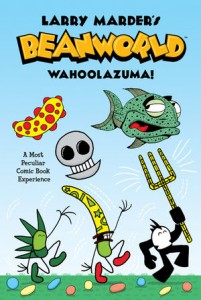
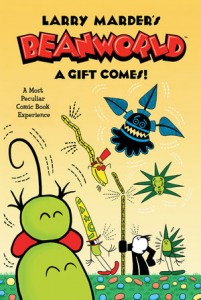
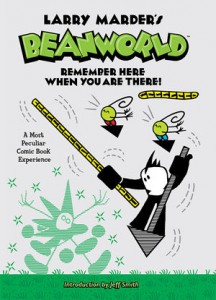
“Beanworld is a weird fantasy dimension operating under its own rules and laws. Beanworld is all about the affinity of life. All the characters, whether they are friends or adversaries, understand that ultimately they depend on each other for survival… It’s not just a place, it’s a process. It is what it is — and th-that’s all folks.’” –Larry Marder, Beanworld
“Beanworld is an all-too-rare experience in comics, or in any medium for that matter — a truly collaborative effort between creator and audience. Stored in Larry’s deceptively simple artwork is a treasure chest of ideas and emotion, waiting to be unlocked by the reader. Our experiences and perceptions are the key that unlocks that chest. But each of us has a different key and each key works in a different way, leading us to a different treasure… It reminded me of the joy of learning a new language, and how that joy had eluded me lately… I can’t tell you what you’ll discover… But I guarantee that whatever you find, it’ll be worth the search. –Scott McCloud Introduction to Beanworld Boston, MA Spring 1989
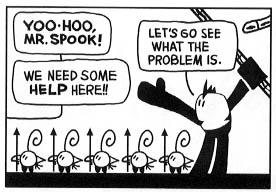 |
| Larry Marder, Beanworld |
The first issue of Beanworld was published in 1985, and the series ran 21 issues until 1993. The series was revived in February 2009 and is now published by Dark Horse Comics in deluxe hardcover editions. Wahoolazuma (February 2009) reprinted the first nine issues. A Gift Comes! came out in July 2009, and a new one-shot comic came out in December 2008. A third hardcover volume, Remember Here When You Are There! came out in November 2009, with all new material. Further volumes are planned.
Marder notes that his work has been strongly influenced by Marcel Duchamp and this is obvious on many levels. This in itself is worthy of lessons integrating art, history, and the art and magic of storytelling.
The MOMA (Museum of Modern Art, NYC), which exhibits several Duchamp pieces, introduces Duchamp with the following excerpt:
French painter, sculptor and writer. The art and ideas of Duchamp, perhaps more than those of any other 20th-century artist, have served to exemplify the range of possibilities inherent in a more conceptual approach to the art-making process. Not only is his work of historical importance — from his early experiments with Cubism to his association with Dada and Surrealism — but his conception of the ready-made decisively altered our understanding of what constitutes an object of art. Duchamp refused to accept the standards and practices of an established art system, conventions that were considered essential to attain fame and financial success: he refused to repeat himself, to develop a recognizable style or to show his work regularly. It is the more theoretical aspects implicit to both his art and life that have had the most profound impact on artists later in the century, allowing us to identify Duchamp as one of the most influential artists of the modern era. (Oxford University Press, 2009)
From the chapter “Larry Marder Building Bridges” in Comic Book Rebels: Conversations with the Creators of the New Comics (edited by Stanley Wiaterand and Stephen Bissette; Donald I. Fine, Inc., 1993):
Beanworld is the exact opposite of most modern comics. The artwork is really simple and the storyline’s quite complex. Most comics have complicated artwork supporting very simple storylines… Obviously Beanworld works on two levels… like Rocky and Bullwinkle the sense that there are many levels of complexity the reader can draw from the story, but the surface level is accessible enough for children to enjoy it, which is something that took me completely by surprise.
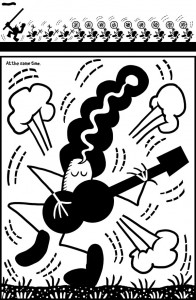 |
| Larry Marder, Beanworld |
Larry Marder’s Beanworld looks at life with an unusual lens that allows us to reflect as well as laugh at its perplexities, its challenges, and all its wonderful quirks. Its packed panels offer readers a refreshing look at life, while the playful language and illustrations teach us all about balance — balancing the fun, balancing the love, balancing individuality and community, and balancing responsibilities.
What life’s ultimate secret is, however, may be different for each of us, but it’s all here for us to discover! That said, Beanworld is a combination of pure fun with its wonderful world play (like “Hoka-hoka Gunk’l’dun,” “Wahoolazuma,” Chowdown Time, and lots of goof-off days) and with its fabled origins embedded in a tribal mythology. While it may take some time to learn the specific language of Beanworld, the series is at once deep as it is simplistic. It is fantasy, allegory, and real life. As the life, trials, and tribulations of Beanworld’s inhabitants unfold, we learn:
- How to balance diversity and individuality on a personal level, on a communal level, and on an ecological level;
- How to keep personal interests and passions alive while meeting the pressing responsibilities that come living in a self-sustaining community;
- How to be creative in variety of different ways:
- How partnerships and teamwork are formed and used to the benefit of all;
- How everything in life has balances, realizing everything has a cost;
- How the healthiest communities and business deals are those where everyone receives some benefit — even when there is some form of loss involved;
- How compassion and appreciation are more effective than violence;
- How issues of parenting, conservation of resources, of diplomacy, and of supply and demand are best met openly and honestly
SERIES SUMMARY
 |
| Larry Marder, Beanworld |
Beanworld: Wahoolazuma! introduces us to the life, characters, and ways of Beanworld. Beanworld consists of an island surrounded by the Thin Lake and supported (both literally and figuratively) by the Four Realities (slats, hoops, twinks, and chips), which Professor Garbanzo has learned to fashion into useful tools. Below the Four Realities is the Bone Zone, followed by the Hoi-Polloi Ring Herd, and finally, Der Stinkle. Every zone, being, and product plays an integral role in this ecosystem.
For most Beans in Beanworld, life consist of “hunting” for Chow, which sustains them, and engaging in Goof-off Days where they can pursue their individual interests and passions. A select few, like Professor Garbanzo, Beanish, and the Boom’r Band have their respective specialized jobs and don’t participate in Chow raids.
The hunters or Chow Sol’jers are led by Mr. Spook with his trusty Fork and a freshly-caught Sprout-Butt. This motley crew regularly jump into the Thin Lake and pass through the Four Realities to the Hoi-Poloi. While spears are flung at the smallest ring to distract and ultimately breach the Hoi-Polloi ring surrounding their cherished Chow, the Chow-Pluk’rs pluck the chow from under them. However, to guarantee some form of balance and “fairness,” the Beans leave the new Sprout-Butt as payment for the ‘pluck’d’ chow. We also learn, however, that the Beans and Hoi-Polloi are not without other external challenges and threats.
 Beanworld: A Gift Comes! continues
the evolving Beanworld narrative with the birth of its next generation
of Beans, the Pod’l’pool Cuties,. In this volume, Mr. Spook must come to grips with the loss
of his Fork (destroyed by the Goofy Service Jerks). In this second
volume, we learn about childhood and child raising. We learn about Mr. Spook’s “problemed childhood” and how, with
the help of Mr. Teach’m (who raised him on a cloud), Mr. Spook was
mentored to be a hero. We also learn how Professor Garbanzo first
discovered the Four Realities, and we continue to see the benefits of
“the arts.”
Beanworld: A Gift Comes! continues
the evolving Beanworld narrative with the birth of its next generation
of Beans, the Pod’l’pool Cuties,. In this volume, Mr. Spook must come to grips with the loss
of his Fork (destroyed by the Goofy Service Jerks). In this second
volume, we learn about childhood and child raising. We learn about Mr. Spook’s “problemed childhood” and how, with
the help of Mr. Teach’m (who raised him on a cloud), Mr. Spook was
mentored to be a hero. We also learn how Professor Garbanzo first
discovered the Four Realities, and we continue to see the benefits of
“the arts.” Beanworld: Remember Here When You Are There! is described as the conclusion to Beanworld’s “Springtime Cycle.” In this third installment of the Beanworld story, the plot and its characters continue to bloom and grow. The Pod’l’pool Cuties are leaving their pool and learning the ways of Beanworld. In his evolving love story, Beanish toils over his love song to Dreamishness, and we see the long-awaited return of Heyoka (a Bean who one day simply left), and the Big Fish (who first gave Mr. Spook his fork). There are many more twink discoveries, and we learn more about the past with hints of the future.
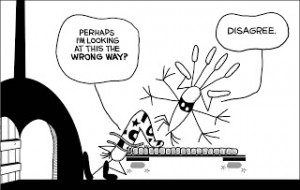 |
| Larry Marder, Beanaworld |
TEACHING/DISCUSSION SUGGESTIONS: Note that more teaching and discussion suggestions can be found at http://cbldf.org/2015/05/using-graphic-novels-in-education-beanworld/
Plot, Themes, and Values Related
- Discuss the individuality of each of the Beanworld characters and how they work together (even when at odds) for the benefit of the Bean society. Discuss and evaluate their relationships and interdependence.
- Chart, discuss, and evaluate the different parables of life one might garner from these three books, and the unimposing way they’re presented.
- Discuss and evaluate the Cycle of Life in Beanworld and how it does or does not relate to your community.
- Throughout this series, while the various communities and cultures coexist, there are threats and secrets. Discuss how these secrets may threaten Beanworld. Discuss when and why it’s important to keep secrets and when and why it’s important to divulge secrets. How does one recognize those times?
- Discuss and evaluate Mr. Spook’s dependence on his Fork. Discuss how he comes to grips with its loss. Discuss what things your students come to depend upon and how they might deal with their loss.
- Evaluate the roles of art and music throughout the series. How does it compare to the role of art and music in your school/community?
- Discuss the pros and cons of Goof-Off Day.
 |
| Larry Marder, Beanworld |
Critical Reading and Making Inferences
- Throughout the Beanworld narrative, Marder makes references to various cultural icons, characters, and events. Search, research, and discuss these references. For example, many of the character names carry references and innuendos, and in Wahoolazuma (p. 101), the Professor says, “Alas poor twinks, we know you not.” Discuss this reference to Shakespeare, compare its use n Beanworld and in the original, and evaluate who affective it is here.
- When discussing the cycle of life on and under Beanworld, Marder notes the Beans “steal but leave payment” when collecting their Chow from the Hoi-Polloi. Discuss and evaluate the ethics and effectiveness of this method of survival for both cultures. Is it okay? Are there better ways to co-exist?
- In Wahoolazuma, to learn from the Ho-Polloi, Professor Garbanzo challenges them to a riddle. One Hoi-Polloi says, “She’s gonna ask a STUPID question ‘cuz she’s a STUPID bean!” Another asks, “How will we decide if it’s a stupid question?” and the first answers, “If it has a stupid answer, of course!” Discuss if there is such a thing as a stupid question. How does one define or identify “stupid questions”?
- Marder devotes a good part of A Gift Comes to the raising of the Cuties. Discuss and evaluate the Beans’ parenting and Cutie-raising techniques.
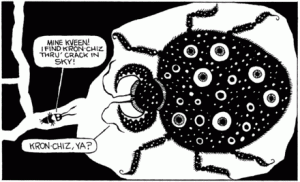 |
| Larry Marder, Beanworld |
- Search and discover Marder’s wonderful wordplay throughout the series. You may want to have students create their own additions to Marder’s created language.
- Identify puns, alliteration, invented worlds, and play on words. You may want students to work on teams to search for these gems, and then create some of their own examples.
Cultural Heritage and Cultural Diversity
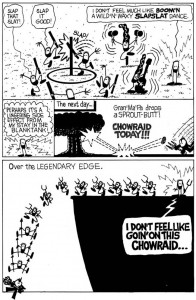 |
| Larry Marder, Beanworld |
- Following the warning, the narrator says, “Mr. Spook doesn’t understand the WARNING SONG. Instead, he hears an awful insect noise…TOTAL DIPLOMATIC FAILURE!” Discuss the diplomatic failure here, and compare this example to examples from your communities, from history, or from current events.
- Discuss the social structure of Beanworld, and compare it to various social/cultural structures in our world today.
- Discuss and evaluate the Professor’s use of scientific method as she investigates the forms, functions, and uses of the Four Realities. Then brainstorm, invent, and experiment to come up with their own new Four Realities materials.
- Discuss and evaluate the subtle and overt ecological messages throughout the narrative. What can we learn from Beanworld?
- Discuss and evaluate the low-tech culture of Beanworld versus our own modern hi-tech culture. What are the strengths and challenges of each?
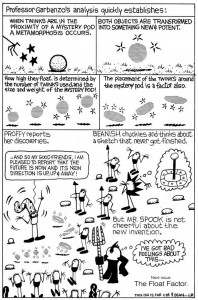 |
| Larry Marder, Beanworld |
In graphic novels, images are used to relay messages with and without accompanying text, adding additional dimension to the story. In Beanworld Larry Marder brilliantly weaves story and background with image, and emotions and insights through text, image, and design. Reading Beanworld together with your students allows you to analyze, discuss, and learn how Marder uses page and panels, text and images to relay complex messages. For example:
- While the images seem simplistic, they carry tremendous depth and detail. Evaluate and discuss Marder’s use of facial expressions and body language to relay information.
- Evaluate and discuss how very small differences (to hair, size, face, hats, chips, arms and legs, for example) distinguish these deceivingly simplistic Beans.
- Evaluate and discuss how Marder uses chunky shapes and patterns in his two-dimensional world that is altogether real and engaging.
- Analyze how his choice of font, design, panel size and shape are all used to relay different character moods.
- Marder also plays a lot with the borders of his panels. Discuss why certain panel formats change when they change, and evaluate what this is trying to tell the reader.
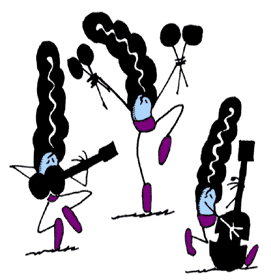 |
| Larry Marder, Beanworld |
Relaying suggested paired readings is particularly challenging for Beanworld. Beanworld is, as noted, a “most peculiar comic book experience,” and as Scott McCloud notes of its thousands of readers, “all left thinking different things.” As a result, suggesting paired readings is difficult because Beanworld is appropriate for so many different readers from tweens through adulthood. That said, for greater discussion on literary style, related themes, similar characters and/or content here are some book suggestions you may want to pair and read:
- Bone by Jeff Smith — a different series of engaging characters that reflect the wisdoms and peculiarities of life’s challenges.
- Frederick by Leo Leoni — a picture book (for the younger spectrum of Beanworld readers) about life and importance of the arts.
- Watership Down by Richard Adams — a timeless classic set in England’s Downs about the courage and survival of a warren of rabbits.
- Flatland: A Romance of Many Dimensions by Edwin A Abbott — a delightfully different and equally “peculiar” reading experience of residents of two-dimensional Flatland (teens and older).
- The Giving Tree by Shel Silverstein (all readers) — about a tree (much like Gran’Ma’Pa) who gives all it can give to one particular boy.
WAHOOLAZOOMA!!!!! Give this series a try.
AND....As always, thank you for your visit.
Please leave your parting reactions in the comments below.
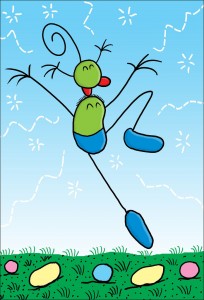 |
| Larry Marder, Beanworld |
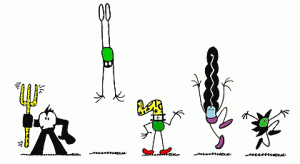
And it truly is a 'wonderful world' - great choice for W.
ReplyDeleteFirst time to hear about this.
ReplyDeleteMy ABC WEDNESDAY
I always like maps of imaginary worlds.
ReplyDeleteThanks for making us all aware of this series♪ http://lauriekazmierczak.com/wispy-desert-bush/
ReplyDeleteThe logo of the comics looks like something from Carl Barks' ducks (Donald, Uncle Scrooge)
ReplyDeleteROG, ABCW